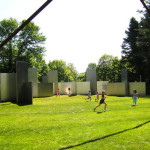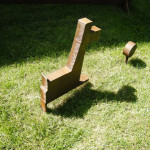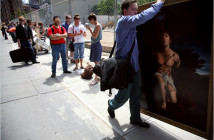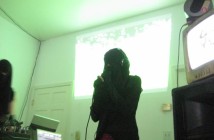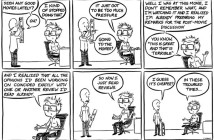TUFTE @ ALDRICH CONTEMPORARY ART MUSEUM
There is always a vanity to the making of art, although there is a difference between vanity of intention and vanity of scale. But that distinction is not relevant here. Edward Tufte apparently has the resources to make whatever he wants out of any material that strikes him. The landscape itself has been reconfigured and replanted for this exhibit, although that new framing is not documented in the exhibition materials. It is as if there is a secret history running parallel to the very public gathering of forms around the property.
Having walked with Tufte through the expansive setting of one of his sculpture fields elsewhere in Connecticut, there is a contrasting sense here of works crowded in, cramped by each other¹s presence. Think of happening upon one of those airplane graveyards in the southwest where in one corner the remains of failed experiments in grand weaponry have been piled. An upright steel tower evokes the abandoned construction of some fantastic windmill.
Insistent as Tufte is in writing upon a first encounter with his sculptures as abstractions, free of analogues or similes, his titles are almost inevitably directive, from birds to rockets to smiles. There is definition everywhere, and a sense of numbers playing themselves out, a mathematics in the topography. But, like those tailors who measure the emperor¹s new clothes, this all seems precise about nothing. Looking, you want these pieces to matter, but fear some trick.
Is the upright bulldozer of Skewed Machine simply a test of gravity and special effects engineering? Is there no more mystery toRocket Science #2 than a childlike delight in goofy assemblage? Escaping Flatland was more like a trap of forms, a metal Stonehenge, until, as I watched, a group of children, vanishing and reappearing among the slabs, turned it into a midsummer stage where indifferent joy found its best setting. And a tree nearby, cabled to keep its lowering branches level, became an accidental participant in the larger game.
Even the warning signs have their own carefully fashioned stanchions, like uncredited actors in an epic film. But is the inscription "Do not climb on the sculptures" with its retro lightning bolts an insurance broker¹s requirement, or another demand for the abstract? It is at least a cartoon threat, implicitly fatal, but not electric.
There is something different at work inside the museum galleries where Tufte¹s work takes on the form of a domestic chamber. Here, the arrangement is all, with the space more at ease, even if more confined. Where the masterworks are reduced, their evocative power becomes more clear, especially in a series of miniature metallic Museo-Theaters of doll house scale, the massive in small, each of which inherits the mystery of Alberto Giacometti's The Palace at 4 A.M. They made me wish that the twig original for the thirty foot tall twisted tripod on the lawn had also found a place on one of the table tops.
While making the photographs for this review I had a sense of practiced contradiction as I turned these objects into subjects, pixel-flattened. These were, in the end, intensely private pleasures which Tufte had fashioned, a self-indulgence now become generous. His notable books about the visual display of information were a singular clue. Behind all this display was an artist desperate for a third dimension that would match the world.
- Edward Tufte, Escaping Flatland, 1998-2004, stainless steel, and Larkin’s Twig (partial), steel, 2004.
- Edward Tufte, Porta the Dog (from a series of 5), steel, 2009.
- Edward Tufte, 8 Candles, 2009; Steel Lines, 2008; Small Tong Bird of Paradise, 2008; all steel
The Aldrich Contemporary Art Museum
"Edward Tufte: Seeing Around" is on view until January 17th, 2010 at The Aldrich Contemporary Art Museum, located at 258 Main Street, Ridgefield, CT.
All images are courtesy of the author and The Aldrich Contemporary Art Museum.


